1993 CHEVROLET LUMINA engine overheat
[x] Cancel search: engine overheatPage 177 of 324
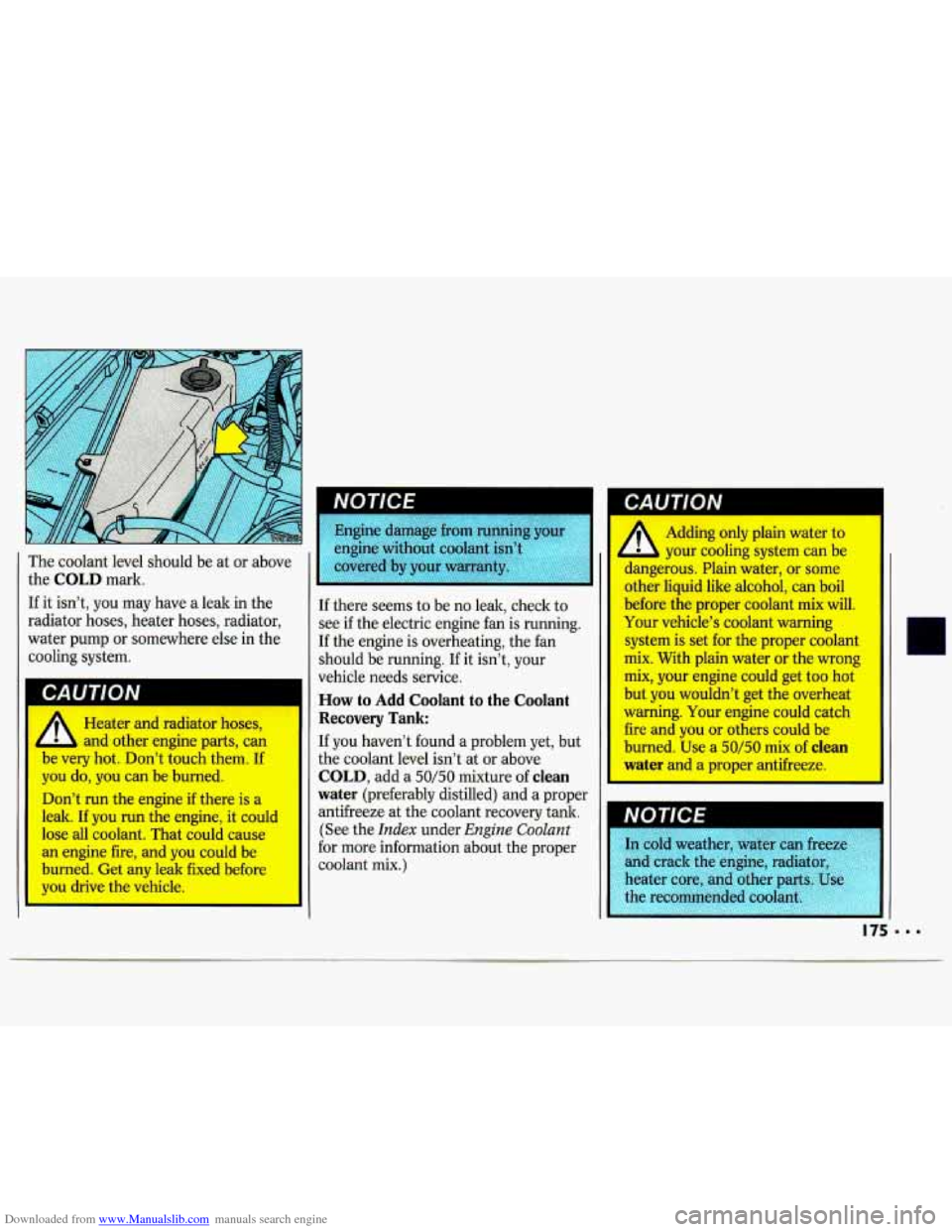
Downloaded from www.Manualslib.com manuals search engine I
The coolant level should be at or above
the
COLD mark.
If it isn’t, you may have a leak in the
radiator hoses, heater hoses, radiator,
water pump or somewhere else in the
cooling system.
Heater and radiator hoses,
L L and other engine parts, can
be very hot. Don’t touch them. If
you do, you can be burned.
Don’t run the engine
if there is a
leak. If you run the engine, it could
lose all coolant. That could cause
an engine fire, and you could be
burned. Get any leak fixed before
you drive the vehicle.
1 NOTlCE CAUTION
If you haven’t found a problem yet, but
the coolant level isn’t at or above
COLD, add a 50/50 mixture of clean
water
(preferably distilled) and a proper
antifreeze at the coolant recovery tank.
(See the
Index under Engine Coolant
for more information about the proper
coolant mix.)
-l
A Adding only plain water to
your cooling system can be
Amgerous. Plain water, or some
~ .ler liquid like alcohol, can boil
before the proper coolant mix will.
Your vehicle’s coolant warning system is set for the proper coolant
mix. With plain water or the wrong
mix, your engine could get too hot
but you wouldn’t get the overheat
warning. Your engine could catch fire and you
or others could be
burned. Use a
50/50 mix of clean
I
I NOTICE
175 .
Page 180 of 324
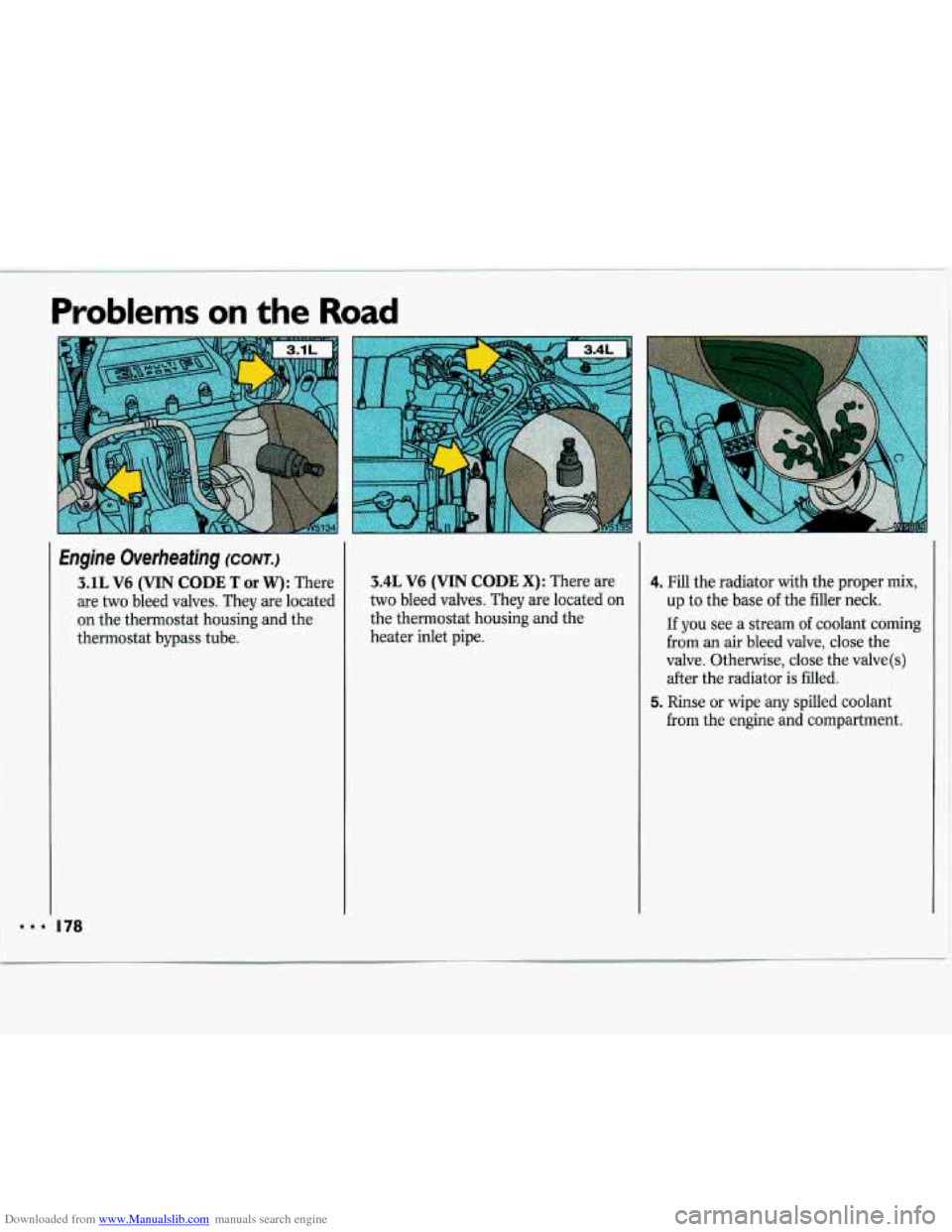
Downloaded from www.Manualslib.com manuals search engine ...
Problems on the Road
Engine Overheating (CONTJ
3.1L V6 (VIN CODE T or W): There
are two bleed valves. They are located
on the thermostat housing and the
thermostat bypass tube. 3.4L V6 (VIN CODE X): There are
two bleed valves. They are located
on
the thermostat housing and the
heater inlet pipe.
I
4. Fill the radiator with the proper mix,
up to the base of the filler neck.
If you see a stream of coolant coming
from an air bleed valve, close the
valve. Otherwise, close the valve(s)
after the radiator is filled.
5. Rinse or wipe any spilled coolant
from the engine and compartment.
I78
Page 182 of 324
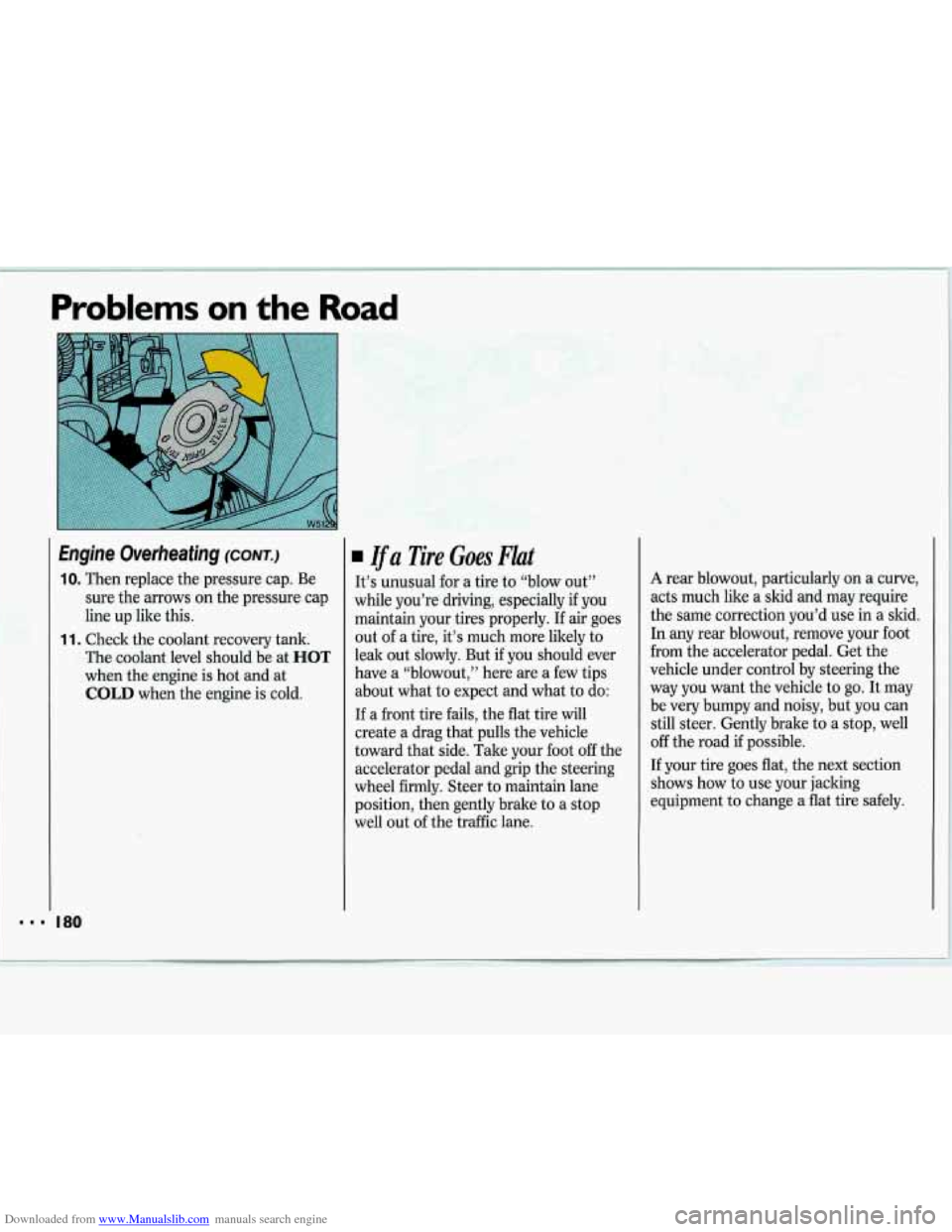
Downloaded from www.Manualslib.com manuals search engine Problems on the Road
Engine Overheating (CONT.)
10. Then replace the pressure cap. Be
sure the arrows on the pressure cap
line up like this.
1 1. Check the coolant recovery tank.
The coolant level should be at
HOT
when the engine is hot and at
COLD when the engine is cold.
- i: .:-
Ifa Tire Goes Flat
It’s unusual for a tire to “blow OU~,)
while you’re driving, especially if you
maintain your tires properly. If air goes
out of a tire, it’s much more likely to
leak out slowly. But
if you should ever
have a “blowout,” here are a few tips
about what to expect and what to do:
If a front tire fails, the flat tire will
create a drag that pulls the vehicle
toward that side. Take your foot
off the
accelerator pedal and grip the steering
wheel firmly. Steer to maintain lane
position, then gently brake to a stop
well out of the traffic lane.
A rear blowout, particularly on a curve,
acts much like a
skid and may require
the same correction you’d use in a
skid.
In any rear blowout, remove your foot
from the accelerator pedal. Get the
vehicle under control by steering the
way you want the vehicle to go. It may
be very bumpy and noisy, but you can
still steer. Gently brake to a stop, well
off the road if possible.
If your tire goes flat, the next section
shows how
to use your jacking
equipment to change a
flat tire safely.
Page 190 of 324

Downloaded from www.Manualslib.com manuals search engine Problems. on the Road
What you don’t want to do when your
vehicle is stuck is to spin your wheels.
The method
known as “rocking” can
help you get out when you’re stuck, but
you must use caution.
CAUTION I
I
r
I
1.1 188
A
If you let your tires spin at
high speed, they can explode
and you or others could be injured.
And, the transaxle or other parts of
the vehicle can overheat. That
could cause an engine compartment
fire or other damage. When you’re stuck, spin the wheels as little as
possible. Don’t spin the wheels
above
35 mph (56 km/h) as shown
on the speedometer. Spinning your wheels can destroy
parts of
your vehicle as well as tht
tires. If you spin the wheels too
fast while shifting your transaxle
back and forth,
YOU~~-&&Q.Y
your transaxle. ~ ~~ ~ 11~1118+~~888 ~:~~,-~~~~~~~~~~,~~~~~~~~~,’,~,’,;,
Rocking Your Vehicle to Get it Out:
First, turn your steering wheel left and
right. That will clear the area around
your front wheels. Then shift back and
forth between
R (Reverse) and a
forward gear (or with a manual
transaxle, between First or Second gear and Reverse), spinning the wheels as
little as possible. Release the accelerator
pedal while you shift, and press lightly
on the accelerator pedal when the
transaxle is in gear. If that doesn’t get
you out after a few tries, you may need
to be towed out.
If you do need to be towed out, see the
Index under Towing Your Chevrolet.
Page 213 of 324

Downloaded from www.Manualslib.com manuals search engine How to Check
The proper fluid should be added if the
level does not reach the bottom of the
diaphragm when it’s
in place in the
reservoir. See the instructions on the
reservoir cap.
Engine Coolant
The following explains your cooling
system and how to add coolant when it
is low. If you have a problem with
engine overheating or
if you need to add
coolant to your radiator, see the
Index
under Engine Overheating.
The proper coolant for you1 ~ ~ ~ _et
will:
Give freezing protection c, .m to
Give boiling protection up to 262°F
Protect against rust and corrosion.
Help keep the proper engine
Let the warning lights work as they
What to Use:
Use a mixture of one-half clean water
(preferably distilled) and one-half
antifreeze that meets
“GM Specification
1825-M,” which won’t damage ,
-34°F (-37°C).
(128°C).
temperature. should. aluminum
parts. You can
also use a
recycled coolant conforming to
GM
Specification 1825-M with a complete
coolant flush and refill. If you use this
mixture, you don’t need to add anything
else.
I
9
Adding only plain water to
your cooling system can be
dangerous. Plain water, or some
other liquid like alcohol, can boil
before the proper coolant mix will.
Your vehicle’s coolant warning
system is set for the proper coolant
mix. With plain water or the wrong
mix, your engine could get too hot
but you wouldn’t get the overheat
warning. Your engine could catch fire and you or others could be
burned. Use a
50/50 mix of clean
water and a proper antifreeze.
Page 216 of 324
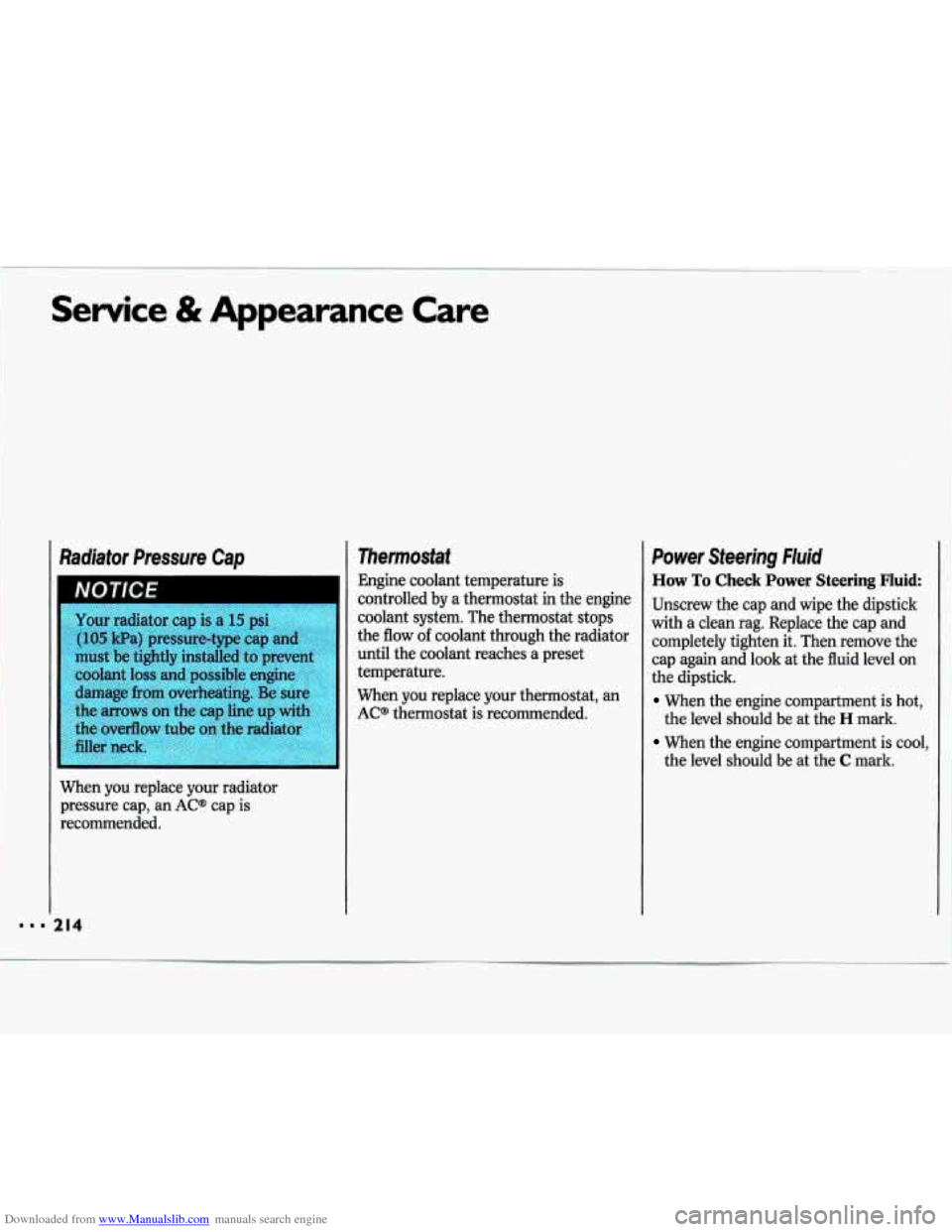
Downloaded from www.Manualslib.com manuals search engine Service & Appearance Care
Radiator Pressure Cap
214
Your radiator cap is a 15 psi
(105 Wa) pressure-type cap and
must be tightly installed to prevent
coolant loss and possible engine
damage
from overheating. Be su
the arrows on the cap line up wi
the overflow tube on the radiato
filler neck.
When you replace your radiator
pressure cap, an
AC@ cap is
recommended.
Thermostat
Engine coolant temperature is
controlled by a thermostat in the engine
coolant system. The thermostat stops
the flow
of coolant through the radiator
until the coolant reaches a preset
temperature.
When you replace your thermostat, an
AC@ thermostat is recommended.
Power Steering Fluid
How To Check Power Steering Fluid:
Unscrew the cap and wipe the dipstick
with a clean rag. Replace the cap and
completely tighten it. Then remove the
cap again and look at the fluid level
on
the dipstick.
When the engine compartment is hot,
When the engine compartment is cool,
the
level should be at the
H mark.
the level should be at the
C mark.
Page 227 of 324
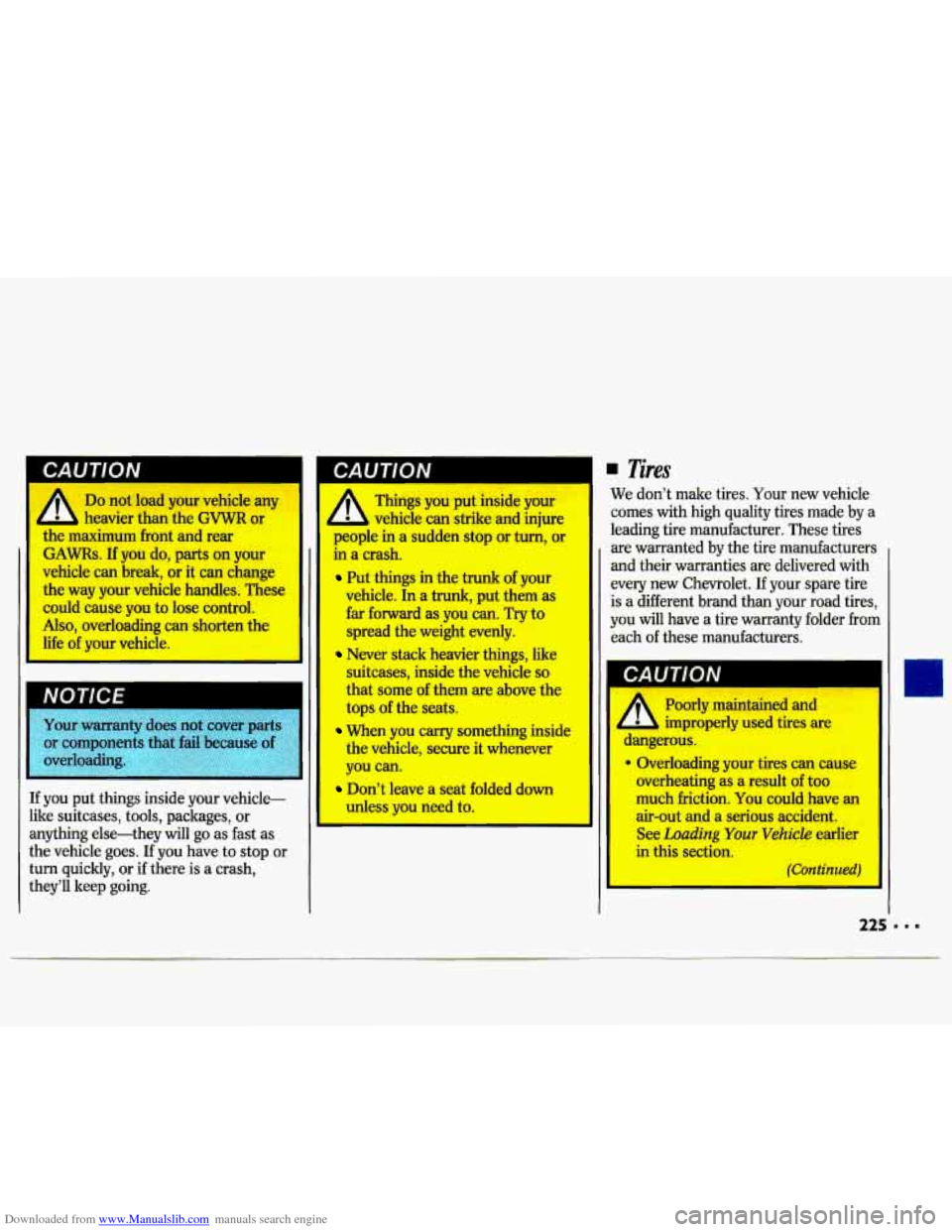
Downloaded from www.Manualslib.com manuals search engine A
Do not load your vehicle any
Things you put inside your
heavier than the
GVWR or b vehicle can strike and iniure
the maximum front and rear
GAMS. If you do, parts on your
vehicle can break, or it can change
the way your vehicle handles. These
could cause you to lose control.
Also, overloading can shorten the
life of your vehicle.
‘I I
If you put things inside your vehicle-
like suitcases, tools, packages, or
anything else-they
will go as fast as
the vehicle goes. If you have
to stop or
turn quickly, or if there is a crash,
they’ll keep going. people
in a sudden
stop or turn, or
in a crash.
Put things in the trunk of your
vehicle. In a trunk, put them as
far forward
as you can. Try to
spread the weight evenly.
Never stack heavier things, like
suitcases, inside the vehicle
so
that some of them are above the
tops
of the seats.
When you wry something inside
the vehicle, secure it whenever
you can.
Don’t leave a seat folded down
unless
you need to.
. Tires
We don’t make tires. Your new vehicle
comes with high quality tires made by a
leading tire manufacturer. These tires
are warranted
by the tire manufacturers
and their warranties are delivered with
every new Chevrolet. If your spare tire
is a different brand than your road tires,
you will have a tire warranty folder from
each of these manufacturers.
A Poorly maintained and
dangerous.
I improperly used tires are
9 Overloading your tires can cause
overheating as a result of too
much friction. You could have an
air-out and a serious accident.
See Loading Your Vehicle earlier
in this section.
(Continued)
Page 248 of 324

Downloaded from www.Manualslib.com manuals search engine Service & Appearance Care
Headlight Wiring
The headlight wiring is protected by a
circuit breaker in the component center.
An electrical overload will cause the
lights to
go on and off, or in some cases
to remain off. If this happens, have your
headlight system checked right away.
Windshield Wipers
The windshield wiper motor is
protected by
a circuit breaker and a
fuse.
If the motor overheats due to
heavy snow, etc., the wiper will stop
until the motor cools.
If the overload is
caused by some electrical problem, have
it fixed.
Power Windows and Other Power
Options
Circuit breakers in the fuse panel
protect the power windows and other
power accessories. When the current
load
is too heavy, the circuit breaker
opens and closes, protecting the circuit
I
until the problem is fixed.